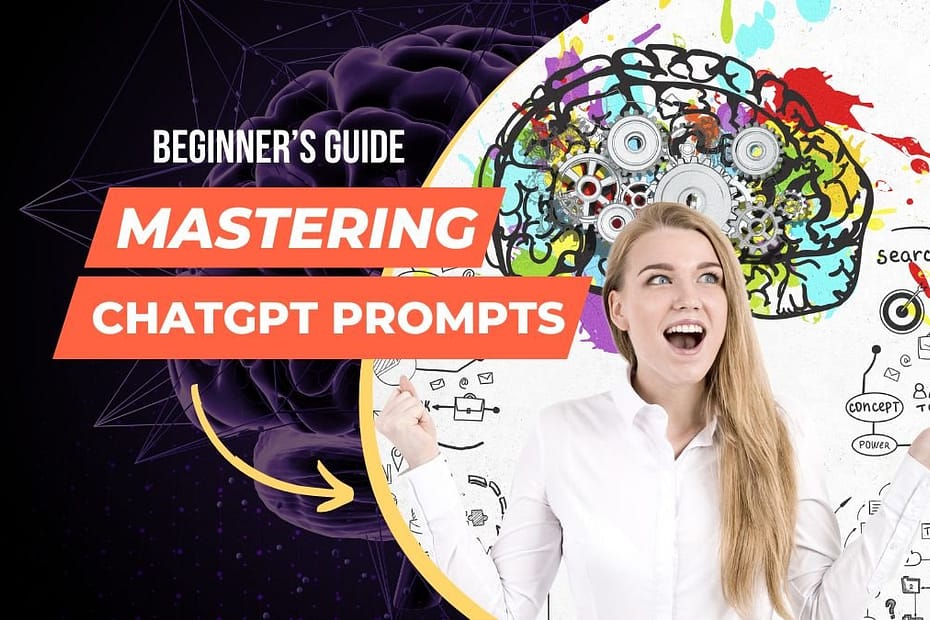Welcome to the AI revolution!
If you’re reading this, chances are you’ve interacted with ChatGPT or any other large language model (LLM) at some point or are about to, and you want to learn more about the art of AI prompting.
Writing good prompts is essential to getting accurate and detailed responses from ChatGPT and other LLMs. But don’t worry, it’s not rocket science, and we’re here to help!
In this guide, we’ll cover everything you need to know to master the art of AI prompting and write better prompts for LLMs, especially ChatGPT. We’ll discuss the basics of AI prompt writing, tailoring your prompts to ChatGPT, best practices for writing effective prompts, and testing and refining your prompts.
So, whether you’re a business owner looking to improve your customer service, a writer needing help with research, or just someone who loves to learn new things, this AI prompting guide is for you. Let’s get started!
Table of Contents
What Are Large Language Models (LLMs)?
Large Language Models (LLMs) are computer programs that can generate text that looks and sounds like it was written by a human. They do this by using complex algorithms to analyze and learn from vast amounts of written material, such as books, articles, and websites.

Some of the most popular LLMs are the ChatGPT series (like GPT-3, GPT-3.5, and GPT-4) developed by OpenAI and Google’s Bard. These models have shown that they can generate text that is almost indistinguishable from human-written text in some cases.
For example, you can give a prompt or a sentence to an LLM, and it can generate a whole paragraph or more of text that follows the same style, tone, and content as the prompt you gave it.
There are many applications for LLMs, including language translation, chatbots, and content creation. For example, companies can use LLMs to generate product descriptions or customer service responses. To use an LLM, you need to have some programming knowledge, or you can use pre-built tools and libraries that are available online.
If you’d like to learn more about LLMs and their applications, here are a few resources that might be helpful:
- OpenAI’s website provides an overview of the GPT models and their capabilities: https://openai.com/gpt/
- The paper introducing GPT-3 provides a detailed technical description of the model and its training: https://arxiv.org/abs/2005.14165
- The TensorFlow website has an introduction to BERT and T5, including tutorials and code examples: https://www.tensorflow.org/text/tutorials/bert_glue
- The Hugging Face website provides a library of pre-trained LLMs and tools for working with them: https://huggingface.co/models
And if you want to learn prompting, here are a couple of platforms that you can visit:
- A massive list of 1500+ AI prompts – https://www.learnprompt.org/
- A free, open-source prompt engineering course covering everything – https://learnprompting.org/
- A collection of amazing ChatGPT prompts – https://prompts.chat/
Understanding the Basics of AI Prompting
When it comes to writing AI prompts for ChatGPT, there are a few basics that you need to understand to get started.
First of all, a prompt is essentially a question or statement that you provide to ChatGPT (or any other LLM) to generate a response. Writing good prompts is essential to getting accurate and detailed responses that meet the user’s needs.
Here are some key things to keep in mind when writing prompts:
- Use clear and concise language: The language you use in your prompts should be clear and easy to understand. Avoid using jargon or technical terms that may be confusing to the user.
- Avoid ambiguity: Your prompts should be specific and unambiguous. Avoid using vague or open-ended questions that can lead to confusing or irrelevant responses.
- Ask the right questions: Your prompts should be designed to elicit the information that the user needs. Ask questions that are relevant and focused on the user’s specific needs.
- Provide context: It’s important to provide enough context in your prompts to help ChatGPT understand the user’s needs. This can include providing information about the user’s background, preferences, or specific situation.
- Avoid assumptions: Don’t assume that you know what the user is looking for. Ask questions that are open-ended and allow the user to provide detailed information.
- Use examples: Providing examples can help to clarify what you’re looking for and help ChatGPT generate more accurate responses.
- Keep it simple: Try to keep your prompts simple and easy to understand. Avoid complex or convoluted language that may be confusing to the user.
By following these basic guidelines, you can write prompts that are clear, concise, and effective in eliciting the information that the user needs. In the next section, we’ll look at how to tailor your prompts to ChatGPT specifically.

Tailoring Your Prompts for ChatGPT
Now that you understand the basics of prompt writing, it’s time to focus on how to tailor your prompts for ChatGPT. ChatGPT is a language model that uses artificial intelligence to generate responses, so it’s important to understand how it works and how to write prompts that fit its capabilities.
First, let’s talk about how ChatGPT’s language model works. The model is trained on a massive dataset of text, which it uses to generate responses to prompts. The model can generate responses that are grammatically correct and make sense in the context of the prompt, but it’s important to keep in mind that the model doesn’t actually understand the meaning of the text.
To tailor your prompts to ChatGPT, it’s important to provide context and information in your prompts. This can help the model to generate more accurate and helpful responses. For example, instead of asking a general question like “What is the weather like?”, provide more context by asking “What is the weather like in New York City today?”.
Another way to tailor your prompts to ChatGPT is to use specific and detailed language. The more specific and detailed your prompts are, the more likely it is that ChatGPT will be able to provide an accurate response. For example, instead of asking “How can I improve my writing?”, ask “What are some tips for improving my writing skills for academic papers?”.
Lastly, it’s important to keep in mind that ChatGPT is not a human, and it may not be able to understand certain types of prompts or provide the level of nuance that a human can. So, when tailoring your prompts to ChatGPT, it’s important to keep them simple and straightforward.
In the next section, we’ll discuss some best practices for writing effective prompts that will help you get the most out of ChatGPT.
Best Practices for Writing Effective Prompts

Now that you have a better understanding of how to tailor your prompts to ChatGPT, let’s look at some best practices for writing effective prompts:
- Use specific and detailed language: The more specific and detailed your prompts are, the more accurate and helpful ChatGPT’s responses will be. Avoid vague or ambiguous language that could be interpreted in multiple ways. For example, instead of asking “What do you think of the new product?” ask “What are your thoughts on the new product’s design and functionality?”
- Ask follow-up questions: Asking follow-up questions can help to clarify your needs and allow ChatGPT to provide more detailed responses. If ChatGPT’s initial response doesn’t fully answer your question or provide enough information, ask a follow-up question to gather more details. For example, if a user asks “What’s the weather like today?”, ChatGPT may provide a general response based on location. But a follow-up question such as “Is it a good option to go outside today?” can help to provide a more relevant and detailed response.
- Break down complex ideas: If you’re asking a question about a complex topic, try to break it down into simpler concepts that ChatGPT can easily understand. For example, if you’re asking a question about quantum mechanics, provide some basic background information to help ChatGPT understand the context and terminology. This will lead to more accurate and relevant responses.
- Be creative: Don’t be afraid to think outside the box when writing prompts. Adding humor, storytelling, or other engaging techniques in your prompts can make the output more interesting and memorable.
- Test and refine your prompts: Just like with any other form of content, testing and refining your prompts is important to ensure they are effective. Use A/B testing or ask for feedback from others to see how users respond to different prompts. Refine your prompts based on the results of your testing, and continually strive to improve them over time.
By following these best practices, you can write more effective prompts that lead to accurate and detailed responses from ChatGPT.
Testing and Refining Your AI Prompts
Congratulations! You’ve learned how to write effective prompts for ChatGPT. But before you start using them, you need to test and refine them to ensure they work as intended. Here are some tips for testing and refining your prompts:
- Use A/B Testing: A/B testing is a technique used to compare two versions of something, in this case, two versions of a prompt. Create two versions of a prompt and test them with different groups of people. Analyze the results to see which version performed better and use the insights to refine your prompts.
- Ask for Feedback: You can also ask for feedback from colleagues, friends, or family members. Ask them to use your prompts and provide feedback on the clarity, relevance, and effectiveness of the prompts.
- Keep Refining: Based on the results of your testing and feedback, refine your prompts to make them more effective. Make changes to the language, structure, or context to make the prompts more accurate and helpful.
Remember, effective prompt writing is an ongoing process. You need to continually refine and improve your prompts over time to ensure they provide accurate and detailed responses. By following these tips, you can create prompts that deliver the results you need from ChatGPT.
Conclusion
In this guide, we’ve explored the art of prompting and how to write effective prompts for ChatGPT. We’ve discussed the basics of AI prompt writing, how to tailor your prompts to ChatGPT, best practices for writing effective prompts, and how to test and refine your prompts.
Effective prompt writing is critical for getting accurate and detailed responses from ChatGPT. By using clear and concise language, providing context and information, and using creative and engaging techniques, you can create prompts that deliver the results you need.
Keep in mind that the key to effective prompt writing is to weigh in your goals and provide prompts that meet your specific needs. By doing so, you can get the results you need from ChatGPT or any other LLM.
FAQs
1. What is prompting in AI?
In AI, prompting refers to the process of providing cues or hints to an AI system to guide its decision-making process. It can be used to improve the performance of the system and reduce errors. Prompting is often used in natural language processing (NLP) tasks such as language generation, question-answering, and dialogue systems.
2. How do you structure an AI prompt?
Structuring an AI prompt involves providing the necessary information and context for the AI system to generate an appropriate response. There are five steps in this process: defining the task, providing context, using clear language, specifying constraints, and testing & refining.

